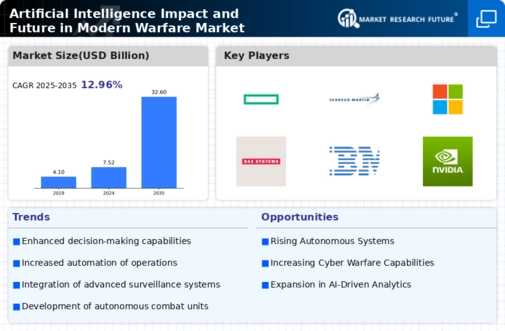Market Growth Projections
The Global Artificial Intelligence Impact and Future in Modern Warfare Market Industry is projected to experience substantial growth in the coming years. With an anticipated market size of 7.52 USD Billion in 2024, the industry is expected to expand significantly, reaching 32.6 USD Billion by 2035. This growth trajectory indicates a robust interest in AI technologies within military applications, driven by advancements in autonomous systems, data analytics, and cybersecurity measures. The compound annual growth rate (CAGR) of 14.25% from 2025 to 2035 further underscores the increasing reliance on AI in modern warfare, suggesting a transformative shift in military operations.
Cybersecurity and AI Integration
The Global Artificial Intelligence Impact and Future in Modern Warfare Market Industry is increasingly focused on the integration of AI in cybersecurity measures. As military networks become more interconnected, the potential for cyber threats escalates. AI technologies are being deployed to enhance threat detection and response capabilities, ensuring the integrity of critical military systems. This proactive approach to cybersecurity not only protects sensitive information but also fortifies operational readiness. With the growing reliance on AI for cybersecurity, the market is poised for substantial growth, as nations prioritize safeguarding their technological assets in an era of digital warfare.
Advancements in Autonomous Systems
The Global Artificial Intelligence Impact and Future in Modern Warfare Market Industry is significantly influenced by advancements in autonomous systems. These technologies, including drones and unmanned ground vehicles, are becoming integral to military operations. The ability to deploy AI-driven autonomous systems allows for real-time data processing and decision-making, which enhances mission success rates. As these systems evolve, they are expected to account for a substantial portion of military capabilities, potentially leading to a market valuation of 32.6 USD Billion by 2035. This shift towards automation indicates a transformative phase in warfare, where human oversight may be complemented or even replaced by AI.
Enhanced Data Analytics and Decision-Making
The Global Artificial Intelligence Impact and Future in Modern Warfare Market Industry is propelled by enhanced data analytics capabilities that AI provides. Military operations generate vast amounts of data, and AI technologies facilitate the analysis of this information, leading to more informed decision-making. The integration of AI in intelligence gathering and battlefield management systems allows for predictive modeling and scenario planning, which can significantly improve operational outcomes. As the demand for data-driven strategies increases, the market is expected to grow at a CAGR of 14.25% from 2025 to 2035, reflecting the critical role of AI in modern military strategies.
International Collaboration and AI Development
The Global Artificial Intelligence Impact and Future in Modern Warfare Market Industry is characterized by international collaboration in AI development. Countries are increasingly recognizing the need for cooperative efforts to advance AI technologies for defense applications. Joint research initiatives and partnerships among nations facilitate knowledge sharing and resource pooling, which accelerates innovation in military AI applications. This collaborative approach not only enhances technological capabilities but also fosters strategic alliances, potentially reshaping global military dynamics. As nations work together to harness the power of AI, the market is likely to experience accelerated growth and diversification.
Increased Military Investment in AI Technologies
The Global Artificial Intelligence Impact and Future in Modern Warfare Market Industry is witnessing a surge in military investment as nations recognize the strategic advantages offered by AI technologies. In 2024, the market is projected to reach 7.52 USD Billion, driven by defense budgets that increasingly allocate funds towards AI-driven systems. Countries such as the United States and China are leading this trend, investing heavily in autonomous systems, predictive analytics, and AI-enhanced decision-making tools. This focus on modernization is likely to enhance operational efficiency and effectiveness, thereby reshaping the landscape of modern warfare.
























Leave a Comment